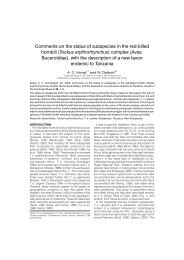EAZA Hornbill Management and Husbandry Guidelines
EAZA Hornbill Management and Husbandry Guidelines
EAZA Hornbill Management and Husbandry Guidelines
Create successful ePaper yourself
Turn your PDF publications into a flip-book with our unique Google optimized e-Paper software.
Fruits <strong>and</strong> vegetables used in captive hornbill diets are generally low in natural chelators<br />
(e.g. phytates, fiber <strong>and</strong> tannins) that may play an important role in mediating absorption<br />
of dietary iron in nature (E. Dierenfeld, <strong>Hornbill</strong> Digest Listserv 1998). Therefore, a<br />
paucity of natural cheleators in zoo diets could also play a role in the disease in captivity.<br />
Additionally, several studies in both mammals <strong>and</strong> birds have shown that ascorbic acid<br />
(Vitamin C) increases iron take up (Johnston, undated). Immunological or nutritional<br />
stress could furthermore predispose at least some birds to this disease.<br />
A female Sunda wrinkled hornbill Aceros corrugatus at Fort Worth Zoo was successfully<br />
treated for hemosiderosis by offering a diet primarily consisting of low-iron pellets<br />
soaked in tea. The tannins in the tea bind the iron <strong>and</strong> prevent it from being stored in the<br />
liver. Her feather condition <strong>and</strong> activity level improved (C. Brown, <strong>Hornbill</strong> Digest<br />
Listserve, 1998). A study of the effect of feeding tea on avian iron levels is currently<br />
being studied at Riverbanks Zoo, U.S.A. (Johnston, undated). However, tannins can only<br />
bind a limited amount of iron, <strong>and</strong> are generally not viewed as the solution to iron storage<br />
problems (G. Dorrestein, pers. comm.).<br />
Phlebotomy (blood letting) is often used as treatment, on the premises that birds making<br />
replacement blood will draw on iron in the liver. Practitioners usually start with removal<br />
of 1% of blood per week, while testing to ensure that the bird does not become anaemic.<br />
Bloodletting may be continued periodically for two or three years before complete<br />
remission of the disease is declared (Johnston, undated). A recent study using an oral<br />
chelator to bind iron in pigeons <strong>and</strong> chickens was inconclusive because of death of the<br />
study subjects. Daily injection of deferoxaminemesilate (Desferal) is currently the most<br />
reliable means to decrease the amount of stored iron. It is expected that in the future this<br />
treatment will be available orally. It is important that effectiveness of methods used be<br />
investigated by liver biopsies.<br />
While there is much to be learned before this disease can be adequately prevented, there<br />
are some steps that can be taken to try to ensure that susceptible birds take up as little iron<br />
as possible:<br />
- Use a low-iron (see also Section 5.1.7: Iron) <strong>and</strong> low-heavy metal diet. Sheppard<br />
<strong>and</strong> Dierenfeld (2000) recommend a diet that contains 50-100 mg/kg iron, on a<br />
dry matter basis. G. Dorrestein (pers. comm.) suggests that an effort should be<br />
made to stay below 50 mg/kg (see 5.3: Diet suggestions).<br />
- Avoid feeding items high in Vitamin C<br />
16




